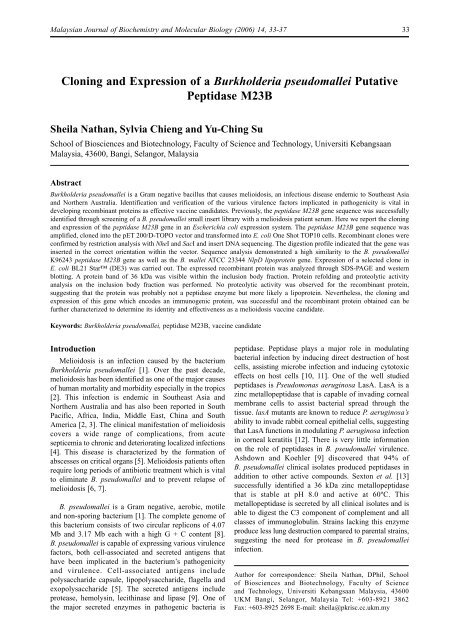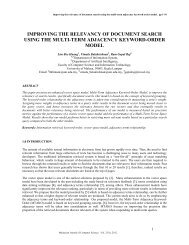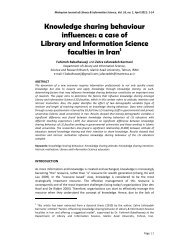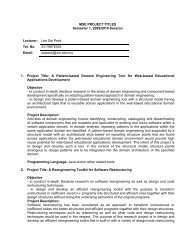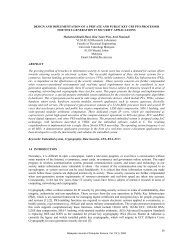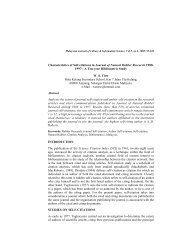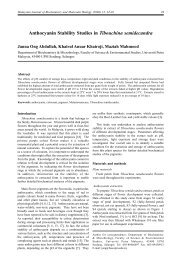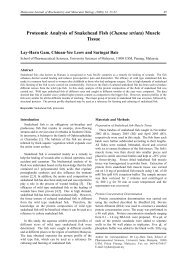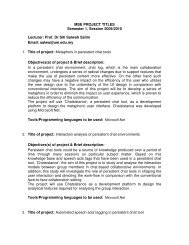Cloning and Expression of a Burkholderia pseudomallei ... - EJUM
Cloning and Expression of a Burkholderia pseudomallei ... - EJUM
Cloning and Expression of a Burkholderia pseudomallei ... - EJUM
Create successful ePaper yourself
Turn your PDF publications into a flip-book with our unique Google optimized e-Paper software.
Malaysian Journal <strong>of</strong> Biochemistry <strong>and</strong> Molecular Biology (2006) 14, 33-37<br />
33<br />
<strong>Cloning</strong> <strong>and</strong> <strong>Expression</strong> <strong>of</strong> a <strong>Burkholderia</strong> <strong>pseudomallei</strong> Putative<br />
Peptidase M23B<br />
Sheila Nathan, Sylvia Chieng <strong>and</strong> Yu-Ching Su<br />
School <strong>of</strong> Biosciences <strong>and</strong> Biotechnology, Faculty <strong>of</strong> Science <strong>and</strong> Technology, Universiti Kebangsaan<br />
Malaysia, 43600, Bangi, Selangor, Malaysia<br />
Abstract<br />
<strong>Burkholderia</strong> <strong>pseudomallei</strong> is a Gram negative bacillus that causes melioidosis, an infectious disease endemic to Southeast Asia<br />
<strong>and</strong> Northern Australia. Identification <strong>and</strong> verification <strong>of</strong> the various virulence factors implicated in pathogenicity is vital in<br />
developing recombinant proteins as effective vaccine c<strong>and</strong>idates. Previously, the peptidase M23B gene sequence was successfully<br />
identified through screening <strong>of</strong> a B. <strong>pseudomallei</strong> small insert library with a melioidosis patient serum. Here we report the cloning<br />
<strong>and</strong> expression <strong>of</strong> the peptidase M23B gene in an Escherichia coli expression system. The peptidase M23B gene sequence was<br />
amplified, cloned into the pET 200/D-TOPO vector <strong>and</strong> transformed into E. coli One Shot TOP10 cells. Recombinant clones were<br />
confirmed by restriction analysis with NheI <strong>and</strong> SacI <strong>and</strong> insert DNA sequencing. The digestion pr<strong>of</strong>ile indicated that the gene was<br />
inserted in the correct orientation within the vector. Sequence analysis demonstrated a high similarity to the B. <strong>pseudomallei</strong><br />
K96243 peptidase M23B gene as well as the B. mallei ATCC 23344 NlpD lipoprotein gene. <strong>Expression</strong> <strong>of</strong> a selected clone in<br />
E. coli BL21 Star (DE3) was carried out. The expressed recombinant protein was analyzed through SDS-PAGE <strong>and</strong> western<br />
blotting. A protein b<strong>and</strong> <strong>of</strong> 36 kDa was visible within the inclusion body fraction. Protein refolding <strong>and</strong> proteolytic activity<br />
analysis on the inclusion body fraction was performed. No proteolytic activity was observed for the recombinant protein,<br />
suggesting that the protein was probably not a peptidase enzyme but more likely a lipoprotein. Nevertheless, the cloning <strong>and</strong><br />
expression <strong>of</strong> this gene which encodes an immunogenic protein, was successful <strong>and</strong> the recombinant protein obtained can be<br />
further characterized to determine its identity <strong>and</strong> effectiveness as a melioidosis vaccine c<strong>and</strong>idate.<br />
Keywords: <strong>Burkholderia</strong> <strong>pseudomallei</strong>, peptidase M23B, vaccine c<strong>and</strong>idate<br />
Introduction<br />
Melioidosis is an infection caused by the bacterium<br />
<strong>Burkholderia</strong> <strong>pseudomallei</strong> [1]. Over the past decade,<br />
melioidosis has been identified as one <strong>of</strong> the major causes<br />
<strong>of</strong> human mortality <strong>and</strong> morbidity especially in the tropics<br />
[2]. This infection is endemic in Southeast Asia <strong>and</strong><br />
Northern Australia <strong>and</strong> has also been reported in South<br />
Pacific, Africa, India, Middle East, China <strong>and</strong> South<br />
America [2, 3]. The clinical manifestation <strong>of</strong> melioidosis<br />
covers a wide range <strong>of</strong> complications, from acute<br />
septicemia to chronic <strong>and</strong> deteriorating localized infections<br />
[4]. This disease is characterized by the formation <strong>of</strong><br />
abscesses on critical organs [5]. Melioidosis patients <strong>of</strong>ten<br />
require long periods <strong>of</strong> antibiotic treatment which is vital<br />
to eliminate B. <strong>pseudomallei</strong> <strong>and</strong> to prevent relapse <strong>of</strong><br />
melioidosis [6, 7].<br />
B. <strong>pseudomallei</strong> is a Gram negative, aerobic, motile<br />
<strong>and</strong> non-sporing bacterium [1]. The complete genome <strong>of</strong><br />
this bacterium consists <strong>of</strong> two circular replicons <strong>of</strong> 4.07<br />
Mb <strong>and</strong> 3.17 Mb each with a high G + C content [8].<br />
B. <strong>pseudomallei</strong> is capable <strong>of</strong> expressing various virulence<br />
factors, both cell-associated <strong>and</strong> secreted antigens that<br />
have been implicated in the bacterium’s pathogenicity<br />
<strong>and</strong> virulence. Cell-associated antigens include<br />
polysaccharide capsule, lipopolysaccharide, flagella <strong>and</strong><br />
exopolysaccharide [5]. The secreted antigens include<br />
protease, hemolysin, lecithinase <strong>and</strong> lipase [9]. One <strong>of</strong><br />
the major secreted enzymes in pathogenic bacteria is<br />
peptidase. Peptidase plays a major role in modulating<br />
bacterial infection by inducing direct destruction <strong>of</strong> host<br />
cells, assisting microbe infection <strong>and</strong> inducing cytotoxic<br />
effects on host cells [10, 11]. One <strong>of</strong> the well studied<br />
peptidases is Pseudomonas aeruginosa LasA. LasA is a<br />
zinc metallopeptidase that is capable <strong>of</strong> invading corneal<br />
membrane cells to assist bacterial spread through the<br />
tissue. lasA mutants are known to reduce P. aeruginosa’s<br />
ability to invade rabbit corneal epithelial cells, suggesting<br />
that LasA functions in modulating P. aeruginosa infection<br />
in corneal keratitis [12]. There is very little information<br />
on the role <strong>of</strong> peptidases in B. <strong>pseudomallei</strong> virulence.<br />
Ashdown <strong>and</strong> Koehler [9] discovered that 94% <strong>of</strong><br />
B. <strong>pseudomallei</strong> clinical isolates produced peptidases in<br />
addition to other active compounds. Sexton et al. [13]<br />
successfully identified a 36 kDa zinc metallopeptidase<br />
that is stable at pH 8.0 <strong>and</strong> active at 60ºC. This<br />
metallopeptidase is secreted by all clinical isolates <strong>and</strong> is<br />
able to digest the C3 component <strong>of</strong> complement <strong>and</strong> all<br />
classes <strong>of</strong> immunoglobulin. Strains lacking this enzyme<br />
produce less lung destruction compared to parental strains,<br />
suggesting the need for protease in B. <strong>pseudomallei</strong><br />
infection.<br />
Author for correspondence: Sheila Nathan, DPhil, School<br />
<strong>of</strong> Biosciences <strong>and</strong> Biotechnology, Faculty <strong>of</strong> Science<br />
<strong>and</strong> Technology, Universiti Kebangsaan Malaysia, 43600<br />
UKM Bangi, Selangor, Malaysia Tel: +603-8921 3862<br />
Fax: +603-8925 2698 E-mail: sheila@pkrisc.cc.ukm.my
<strong>Cloning</strong> <strong>and</strong> expression <strong>of</strong> B. <strong>pseudomallei</strong> peptidase<br />
34<br />
We have undertaken to identify as many<br />
B. <strong>pseudomallei</strong> immunogenic proteins as possible [Su<br />
et al., in prep]. This identification is vital in developing<br />
effective vaccine <strong>and</strong> diagnostic tools for melioidosis. In<br />
this study, the gene sequence encoding peptidase M23B<br />
was successfully identified through screening <strong>of</strong> a<br />
B. <strong>pseudomallei</strong> small insert library with a melioidosis<br />
patient serum. Here, we report on the cloning, expression<br />
<strong>and</strong> characterization <strong>of</strong> the B. <strong>pseudomallei</strong> peptidase.<br />
Materials <strong>and</strong> Methods<br />
Bacterial DNA genome<br />
B. <strong>pseudomallei</strong> clinical isolate D286 genomic DNA<br />
was obtained from the Pathogen Laboratory, Centre for<br />
Gene Analysis <strong>and</strong> Technology, Universiti Kebangsaan<br />
Malaysia.<br />
Primers for polymerase chain reaction <strong>and</strong> automated<br />
sequencing<br />
Primers for PCR (M23BF1: 5'-CACCATGAGCAAGA<br />
GCGAGATC-3' <strong>and</strong> reverse primer, M23BR1: 5'-<br />
CTAGCCCTGCTGCCGGCTCG-3') were designed based<br />
on the B. <strong>pseudomallei</strong> peptidase M23B gene sequence<br />
(Wellcome Trust Sanger Institute Database on<br />
B. <strong>pseudomallei</strong> K96342) using Primer Premier 4.0.<br />
Primers used for sequencing were the T7 forward <strong>and</strong><br />
reverse primers. Primer sequences used for primer walking<br />
were BpF1: 5'-CGGCGCAGCATCCGGAGCAC-3' <strong>and</strong><br />
BpF2:5'-CTGCAGGCTTGGAACCGGAT-3'.<br />
Polymerase chain reaction<br />
Amplification <strong>of</strong> the B. <strong>pseudomallei</strong> peptidase M23B<br />
gene was carried out using the Exp<strong>and</strong> High Fidelity<br />
PCR System (Roche, Germany) in a final volume <strong>of</strong> 50<br />
µl containing 32.25 µl ddH 2 O, 250 ng template, 40 mM<br />
dNTP, 25 pmol forward <strong>and</strong> reverse primer, 1X PCR<br />
buffer, 25 mM MgCl 2 , 6% dimethyl sulfoxide (DMSO)<br />
<strong>and</strong> 1U Exp<strong>and</strong> High Fidelity Taq Polymerase. The PCR<br />
programme used was: 95ºC for 5 min, 10 cycles <strong>of</strong> 95ºC<br />
for 1 min, 64.6ºC for 1 min <strong>and</strong> 72ºC for 1 min, 20<br />
cycles <strong>of</strong> 95ºC for 1 min, 64.6ºC for 1 min <strong>and</strong> 72ºC for<br />
1 min plus 5 sec per cycle followed by a final 10 min<br />
extension at 72ºC. The PCR product was subjected to 1%<br />
agarose gel electrophoresis. Appropriate positive <strong>and</strong><br />
negative controls were included.<br />
Analysis <strong>of</strong> selected recombinant clones<br />
Twenty transformed colonies were r<strong>and</strong>omly selected<br />
<strong>and</strong> plasmids were extracted using the QIAprep Spin<br />
Miniprep kit (QIAGEN, USA). The recombinant clones<br />
were digested with SacI <strong>and</strong> NheI <strong>and</strong> also subjected to<br />
automated DNA sequencing. The sequence obtained was<br />
analysed against the Wellcome Trust Sanger Institute<br />
database (http://sanger.ac.uk/) by BLAST (http://<br />
www.ncbi.nlm.nih.gov/BLAST).<br />
Recombinant protein expression, analysis <strong>and</strong><br />
characterization<br />
One selected recombinant clone was transformed into<br />
E. coli BL21 Star (DE3) <strong>and</strong> grown overnight on LB<br />
agar containing 50 µg/ml kanamycin at 37ºC. A single<br />
colony was inoculated into 5 ml LB-kan <strong>and</strong> grown<br />
overnight at 37ºC <strong>and</strong> 250 rpm. The overnight culture<br />
(100 µl) was sub-cultured into 10 ml LB-kan to achieve a<br />
1:100 dilution <strong>and</strong> incubated at 30ºC <strong>and</strong> 250 rpm. When<br />
the culture achieved a density <strong>of</strong> 0.6 to 0.8 absorption<br />
value at 600 nm, 1 mM IPTG was added <strong>and</strong> incubation<br />
was continued for five hours. Supernatant <strong>and</strong> inclusion<br />
body fractions were obtained by freeze-thawing <strong>and</strong><br />
sonification in the Vibracell (Sonics <strong>and</strong> Materials, USA)<br />
<strong>and</strong> analyzed through sodium dodesyl sulphate -<br />
polyacrylamide gel electrophoresis (SDS-PAGE) <strong>and</strong><br />
western blotting. Recombinant protein solubilized in 6M<br />
urea was refolded through serial dilution <strong>and</strong> washes to<br />
gradually remove the urea content. The skimmed milk<br />
agar assay <strong>and</strong> zymography were performed to analyze<br />
peptidolytic activity [14].<br />
Results <strong>and</strong> Discussion<br />
Construction <strong>of</strong> recombinant peptidase M23B clone<br />
Analysis <strong>of</strong> the peptidase M23B gene amplification<br />
product by agarose gel electrophoresis demonstrated a<br />
b<strong>and</strong> <strong>of</strong> 950 bp, similar to the expected peptidase M23B<br />
gene size <strong>of</strong> 948 bp (data not shown, indicating the<br />
successful amplification <strong>of</strong> the peptidase M23B gene.<br />
Figure 1 is a representation <strong>of</strong> the constructed peptidase<br />
M23B clone within the pET expression vector.<br />
Amplification <strong>of</strong> the B. <strong>pseudomallei</strong> peptidase M23B<br />
gene was performed using the Exp<strong>and</strong> High Fidelity<br />
PCR System enzyme. This system contains two types <strong>of</strong><br />
enzymes, DNA Taq polymerase <strong>and</strong> DNA Tgo<br />
<strong>Cloning</strong> <strong>of</strong> the peptidase M23B gene<br />
The PCR product was purified with the QIAquick<br />
Gen Extraction Kit according to the manufacturer’s<br />
instructions. The purified PCR product was ligated into<br />
the pET 200/D-TOPO expression vector (2:1 molar ratio).<br />
The ligation mixture was transformed into One Shot<br />
TOP10 competent cells by heat shock. The transformation<br />
mixture was spread on LB agar with 50 µg/ml kanamycin<br />
<strong>and</strong> incubated overnight at 37ºC.<br />
Figure 1: The recombinant pET 200D/Topo – Peptidase<br />
M23B Construct. RBS, ribosome binding site; 6x<br />
HIS, N-terminal Hisitidine tag; X-express epitope,<br />
for detection with the anti X-express antibody;<br />
EK, Enterokinase
<strong>Cloning</strong> <strong>and</strong> expression <strong>of</strong> B. <strong>pseudomallei</strong> peptidase<br />
35<br />
polymerase. The combination <strong>of</strong> these enzymes helps to<br />
produce higher, specific <strong>and</strong> accurate PCR yields [15].<br />
DMSO is usually added as an additive to reduce the<br />
denaturation temperature <strong>of</strong> GC rich templates to improve<br />
the PCR reaction [16].<br />
Analysis <strong>of</strong> recombinant clones<br />
Recombinant clone analysis was carried out by agarose<br />
gel electrophoresis, restriction digestion <strong>and</strong> DNA<br />
sequencing. Twenty clones (BpP1-BpP20) were selected<br />
at r<strong>and</strong>om <strong>and</strong> plasmids were extracted <strong>and</strong> subjected to<br />
size determination (Figure 2). From the electrophoresis<br />
pr<strong>of</strong>ile, only five recombinant plasmids (BpP7, BpP9,<br />
BpP12, BpP15 <strong>and</strong> BpP16) were <strong>of</strong> the expected size <strong>of</strong><br />
6689 bp. Recombinant plasmid BpP12 <strong>and</strong> the pET 200/<br />
D-TOTP vector were subjected to single <strong>and</strong> double<br />
with NheI <strong>and</strong> SacI produced two linearized DNA<br />
fragments <strong>of</strong> 5.7 kb <strong>and</strong> 1 kb each, as expected indicating<br />
that the gene was indeed inserted within the vector. Double<br />
digestion <strong>of</strong> the pET 200/D-TOPO vector produced only<br />
one linearized DNA fragment <strong>of</strong> 5.7 kb (Figure 3).<br />
Automated DNA sequencing <strong>of</strong> the insert was performed<br />
to verify the identity <strong>of</strong> the cloned gene. In this study, the<br />
T7 forward <strong>and</strong> reverse primers were used for DNA<br />
sequencing. Primer walking with the BpF1 <strong>and</strong> BpF2<br />
primers was carried out to enable complete sequencing<br />
<strong>of</strong> the 950 bp insert. The BpP12 insert sequence obtained<br />
was then compared with the B. <strong>pseudomallei</strong> strain<br />
K96243 peptidase M23B gene sequence from The<br />
Wellcome Trust Sanger Institute database<br />
(www.sanger.ac.uk). Alignment <strong>of</strong> both sequences<br />
confirmed the identity <strong>of</strong> the cloned gene as<br />
Figure 2: Electrophoresis pr<strong>of</strong>ile <strong>of</strong> recombinant plasmids.<br />
Lanes 1 & 22: DNA super-coiled marker; Lanes<br />
2 – 21: BpP1 – BpP20<br />
digestion (Figure 3). Restriction digestion was carried<br />
out to ensure that the gene sequence within the clone was<br />
ligated in the correct orientation within the pET 200/D-<br />
TOPO vector. SacI <strong>and</strong> NheI were chosen for ease <strong>of</strong><br />
analysis. Double digestion <strong>of</strong> recombinant plasmid BpP12<br />
Figure 3: Electrophoresis pr<strong>of</strong>ile <strong>of</strong> recombinant plasmid<br />
BpP12 <strong>and</strong> pET 200/D-TOPO vector digested with<br />
NheI <strong>and</strong> SacI. Lane 1: DNA super-coiled marker;<br />
2: pET 200/D-TOPO vector; 3: BpP12; 4: empty;<br />
5: pET 200/D-TOPO vector + NheI; 6: pET 200/<br />
D-TOPO vector + SacI; 7: pET 200/D-TOPO<br />
vector + NheI + SacI; 8: 1 kb DNA ladder; 9:<br />
BpP12 + NheI; 10: BpP12 + SacI; 11: BpP12 +<br />
NheI + SacI<br />
Table 1:<br />
DNA sequence analysis with BLAST towards the Genbank bacterial non-redundant database<br />
Database reference no. Organism Similarity Score E value Protein function<br />
BX571966.1<br />
<strong>Burkholderia</strong> <strong>pseudomallei</strong><br />
K96243<br />
99% 932 0<br />
Peptidase<br />
M23B<br />
CP000125.1<br />
<strong>Burkholderia</strong> <strong>pseudomallei</strong><br />
1710b<br />
99% 932 0<br />
Peptidase<br />
M23B<br />
CP000011.2<br />
<strong>Burkholderia</strong> mallei<br />
ATCC 23344<br />
99% 924 0<br />
Putative NlpD<br />
lipoprotein<br />
B. <strong>pseudomallei</strong> peptidase M23B with 99% similarity to<br />
the K96243 sequence (Table 1). Four base changes were<br />
noted; T294C, C666T, T398C <strong>and</strong> C530T. The first two<br />
changes did not affect the encoded amino acid ie glycine,<br />
whilst the latter two changes caused a change in the<br />
encoded amino acid, from alanine to valine. These<br />
differences were probably due to natural variants amongst<br />
B. <strong>pseudomallei</strong> strains. The sequence analysis also<br />
demonstrated a high similarity <strong>of</strong> the cloned gene sequence<br />
to the B. <strong>pseudomallei</strong> 1710b peptidase M23B (Table 1).<br />
A significant similarity was also shown towards the<br />
B. mallei ATCC 23344 putative NlpD lipoprotein gene<br />
due to the presence <strong>of</strong> a lipoprotein domain within the<br />
BpP12 gene sequence.
<strong>Cloning</strong> <strong>and</strong> expression <strong>of</strong> B. <strong>pseudomallei</strong> peptidase<br />
36<br />
<strong>Expression</strong> <strong>and</strong> characterization <strong>of</strong> recombinant peptidase<br />
M23B<br />
<strong>Expression</strong> <strong>of</strong> the B. <strong>pseudomallei</strong> peptidase M23B<br />
gene was performed in E. coli BL21 Star (DE3) at<br />
30ºC with 1 mM IPTG induction. <strong>Expression</strong> was carried<br />
out at a lower temperature to avoid formation <strong>of</strong> inclusion<br />
bodies [17]. The growth <strong>of</strong> E. coli is slower at<br />
temperatures below 37ºC [18], thus, an induction time <strong>of</strong><br />
3 <strong>and</strong> 5 hours was performed to determine the optimal<br />
induction period. <strong>Expression</strong> <strong>of</strong> the peptidase M23B gene<br />
was expected to produce a protein <strong>of</strong> 36 kDa.<br />
The expressed recombinant protein was analyzed<br />
through SDS-PAGE <strong>and</strong> western blotting. No protein<br />
b<strong>and</strong> <strong>of</strong> 36 kDa was visible for the supernatant fraction<br />
(Figure 4a). For the inclusion body fraction, a b<strong>and</strong> <strong>of</strong><br />
36 kDa was obtained for cultures induced with IPTG<br />
for 3 <strong>and</strong> 5 hours (Figure 4b). For the uninduced clone,<br />
no protein b<strong>and</strong> <strong>of</strong> 36 kDa was observed, suggesting<br />
that induction with IPTG is required for peptidase M23B<br />
gene expression to take place. The positive control,<br />
lacZ produced a thick b<strong>and</strong> <strong>of</strong> 120 kDa as expected.<br />
Comparison <strong>of</strong> intensity <strong>of</strong> the b<strong>and</strong>s for the 3 <strong>and</strong> 5<br />
hour induction time showed that the 5-hour induction<br />
period produced more recombinant protein. Thus, all<br />
further expression was conducted with 5 hour induction.<br />
For the western analysis, anti-HisGly antibody was used<br />
to detect expressed recombinant protein as the<br />
Figure 4: SDS-PAGE <strong>and</strong> western blot analysis <strong>of</strong> expressed<br />
recombinant protein BpP12 at 30ºC with 1 mM<br />
IPTG induction for 3 <strong>and</strong> 5 hours. (a) SDS-PAGE<br />
pr<strong>of</strong>ile for the supernatant fraction, (b) SDS-<br />
PAGE pr<strong>of</strong>ile for the inclusion body fraction, (c)<br />
Autoradiogram <strong>of</strong> the inclusion body fraction<br />
protein sample detected with anti-HisGly<br />
antibody. Lane 1: BL21 Star (DE3) – IPTG; 2:<br />
BL21 Star (DE3) + IPTG; 3: pET 200/D-TOPO<br />
vector – IPTG; 4: pET 200/D-TOPO vector +<br />
IPTG; 5: broad range st<strong>and</strong>ard protein marker;<br />
6: recombinant clone BpP12 – IPTG; 7:<br />
recombinant clone BpP12 + IPTG (3 hr); 8:<br />
recombinant clone BpP12 + IPTG (5 hr); 9: pET<br />
200/D/lacZ – IPTG; 10: pET 200/D/lacZ + IPTG<br />
recombinant protein is fused to a polyhistidine tag at<br />
the N-terminal. From the representative autoradiogram,<br />
a protein b<strong>and</strong> <strong>of</strong> 36 kDa was detected in the IPTG<br />
induced samples <strong>of</strong> both 3 <strong>and</strong> 5 hour induction (Figure<br />
4c). The expressed recombinant protein obtained was<br />
insoluble eventhough expression was carried out at the<br />
lower temperature. This situation might occur in<br />
instances where bacterial cells are cultured in rich<br />
medium like LB medium whereupon, their growth rate<br />
becomes faster <strong>and</strong> this disrupts proper protein folding<br />
leading to formation <strong>of</strong> insoluble protein in inclusion<br />
bodies [19].<br />
We assayed the recombinant protein for protease<br />
activity via skimmed milk hydrolysis. When sufficient<br />
activity is presernt, the formation <strong>of</strong> a clear halo<br />
surrounding the colonies on agar caused by hydrolisis<br />
<strong>of</strong> casein substrate in the skimmed milk is usually<br />
observed [16]. However, for the peptidase M23B bearing<br />
clones, no clear halo formation was observed (data not<br />
shown). In addition to the skimmed milk agar assay,<br />
M23B peptidase activity was also monitored by<br />
zymography. Zymogram is a fast <strong>and</strong> reliable method to<br />
analyze proteolytic activity after seperation in nonreducing<br />
SDS-PAGE [20, 21]. In zymography, SDS-<br />
PAGE is carried out under non-reducing conditions <strong>and</strong><br />
at cold temperatures to preserve the native state <strong>of</strong> the<br />
protein. Proteolytic activity is confirmed when an<br />
translucent b<strong>and</strong> against a dark background is obtained<br />
after staining <strong>of</strong> the substrate gel. Zymography on the<br />
peptidase M23 recombinant protein also showed no<br />
proteolytic activity, suggesting that the protein encoded<br />
by the peptidase M23B gene lacked proteolytic activity.<br />
Problems in refolding <strong>of</strong> the purified protein may be a<br />
contributory factor, as could be the base differences<br />
observed in the sequence when compared to the K96243<br />
M23B peptidase sequence. The change from Ala to Val<br />
may have resulted in perturbing the active site region <strong>of</strong><br />
the peptidase.<br />
Although the recombinant protein was expected to be<br />
proteolytically active, but this study showed that protein<br />
encoded by the B. <strong>pseudomallei</strong> peptidase M23B gene<br />
did not exhibit any proteolytic activity <strong>and</strong> was probably<br />
not a peptidase enzyme. From the sequence analysis (Table<br />
1), we have shown that the gene sequence was highly<br />
similar to that <strong>of</strong> B. mallei ATCC 23344 putative NlpD<br />
lipoprotein. There are known lipoproteins that have<br />
previously been classified in the peptidase M23B family<br />
such as E. coli NlpD which did not contain proteolytic<br />
activity [22]. A study by Padmalayam et al. [23] showed<br />
that Bartonella bacilliformis lipoprotein, which is also<br />
homologous to E. coli NlpD is immunogenic <strong>and</strong> involved<br />
in this bacterium’s virulence. Lipoprotein B (LppB) from<br />
Haemophilus somnus has been proven to be involved in<br />
causing hemophiliosis in cattle [24]. This suggests that<br />
the protein encoded by the B. <strong>pseudomallei</strong> peptidase<br />
M23B/NlpD lipoprotein gene may act as a virulence factor<br />
for this bacterium.
<strong>Cloning</strong> <strong>and</strong> expression <strong>of</strong> B. <strong>pseudomallei</strong> peptidase<br />
37<br />
Conclusion<br />
In this study, a recombinant clone carrying the gene<br />
sequence encoding the B. <strong>pseudomallei</strong> peptidase M23B<br />
was successfully constructed. DNA sequence analyses<br />
indicated 99% similarity between the recombinant clone<br />
gene sequence <strong>and</strong> B. <strong>pseudomallei</strong> K96243 peptidase<br />
M23B sequence. A high similarity was also shown towards<br />
B. mallei ATCC 23344 putative NlpD lipoprotein. The<br />
recombinant protein was successfully expressed in<br />
E. coli Star (DE3). Protein expression at 30ºC <strong>and</strong><br />
induced with 1 mM IPTG for 3 <strong>and</strong> 5 hours produced<br />
inactive recombinant protein <strong>of</strong> 36 kDa in the inclusion<br />
body fractions. The refolded recombinant protein exhibited<br />
no proteolytic activity both on skimmed milk agar <strong>and</strong><br />
zymogram. This suggests that the expressed recombinant<br />
protein was probably not a peptidase enzyme but could<br />
be a lipoprotein. Further characterization is needed to<br />
determine the identity <strong>and</strong> role <strong>of</strong> this recombinant protein<br />
in B. <strong>pseudomallei</strong> pathogenicity <strong>and</strong> its effectiveness as<br />
a melioidosis c<strong>and</strong>idate vaccine.<br />
Acknowledgement<br />
This research was funded by the Top Down Grant<br />
090202005BTK/ER/29 awarded to S.N. by the<br />
Government <strong>of</strong> Malaysia.<br />
References<br />
1. White NJ. Melioidosis. Lancet 2003; 361: 1715-1722.<br />
2. Dance DAB. Melioidosis: the tip <strong>of</strong> the iceberg? Clinical<br />
Microbiology Review 1991; 4(1): 52-60.<br />
3. Dance DAB. Melioidosis as an emerging global problem<br />
Acta Tropica 2000; 74: 115-119.<br />
4. Shimeld LA, Rodgers AT. Essentials <strong>of</strong> Diagnostic<br />
Microbiology, 1998; New York: Delmar Publishers.<br />
5. Brett PJ, Woods DE. Pathogenesis <strong>of</strong> <strong>and</strong> immunity to<br />
melioidosis. Acta Tropica 2000; 74: 201-210.<br />
6. Currie BJ, Fisher DA, Anstey NM, Jacups SP. Melioidosis:<br />
acute <strong>and</strong> chronic disease, relapse <strong>and</strong> re-activation.<br />
Transactions <strong>of</strong> the Royal Society <strong>of</strong> Tropical Medicine<br />
<strong>and</strong> Hygiene 2000; 94: 301-304.<br />
7. Jenney AWJ, Lum G, Fisher DA, Currie BJ. Antibiotic<br />
susceptibility <strong>of</strong> <strong>Burkholderia</strong> <strong>pseudomallei</strong> from tropical<br />
northern Australia <strong>and</strong> implications for therapy <strong>of</strong><br />
melioidosis. International Journal <strong>of</strong> Antimicrobial Agents<br />
2001; 17: 109-113.<br />
8. Holden MTG, Titball RW, Peacock SJ, Cerden˜o-Ta´rraga<br />
AM, Atkins T, Crossman LC, Pitt T, Churcher C, Mungall<br />
K, Bentley SD, Mohammed Sebaihia, Thomson NR, Bason<br />
N, Beacham IR, Brooks K, Brown KA, Brown NF, Challis<br />
GL, Cherevach I, Chillingworth T, Cronin A, Crossett B,<br />
Davis P, DeShazer D, Feltwell T, Fraser A, Hance Z,<br />
Hauser H, Holroyd S, Jagels K, Keith KE, Maddison M,<br />
Moule S, Price C, Quail MA, Rabbinowitsch E, Rutherford<br />
K, S<strong>and</strong>ers M, Simmonds M, Songsivilai S, Stevens K,<br />
Tumapa S, Vesaratchavest M, Whitehead S, Yeats C, Barrell<br />
BG, Oyston PCF, Parkhill J. Genomic plasticity <strong>of</strong> the<br />
causative agent <strong>of</strong> melioidosis, <strong>Burkholderia</strong> <strong>pseudomallei</strong>,<br />
Proceedings <strong>of</strong> the National Academy <strong>of</strong> Sciences (USA)<br />
2004; 101(39): 14240-14245.<br />
9. Ashdown LR, Koehler JM. Production <strong>of</strong> hemolysins <strong>and</strong><br />
other extracellular enzymes by clinical isolates <strong>of</strong><br />
Pseudomonas <strong>pseudomallei</strong>. Journal <strong>of</strong> Clinical<br />
Microbiology 1990; 28(10): 2331-2334.<br />
10. Maeda, H. Review: Role <strong>of</strong> microbial proteases in<br />
pathogenesis. Microbiology <strong>and</strong> Immunology 1996; 40(10):<br />
685-699.<br />
11. Miyoshi S, Shinoda S. Microbial metalloproteases <strong>and</strong><br />
pathogenesis. Microbes <strong>and</strong> Infection 2000; 2: 91-98.<br />
12. Cowell BA, Twining SS, Hobden JA, Kwong MSF, Fleiszig<br />
SMJ. Mutation <strong>of</strong> lasA <strong>and</strong> lasB reduces Pseudomonas<br />
aeruginosa invasion <strong>of</strong> epithelial cells. Microbiology 2003;<br />
149: 2291-2299.<br />
13. Sexton MM, Jones AL. Purification <strong>and</strong> characterization<br />
<strong>of</strong> a protease from Pseudomonas <strong>pseudomallei</strong>. Canada<br />
Journal <strong>of</strong> Microbiology 1994; 40(11): 903-910.<br />
14. Ling JML, Nathan S, Lee KH, Mohamed R. <strong>Expression</strong><br />
<strong>and</strong> characterisation <strong>of</strong> a B. <strong>pseudomallei</strong> serine<br />
metalloprotease from a recombinant E. coli. Journal <strong>of</strong><br />
Biochemistry & Molecular Biology 2001; 34(6): 509-516.<br />
15. Roche Applied System. 2003. Exp<strong>and</strong> High Fidelity PCR<br />
System.<br />
16. Maniatis T, Fritsh EF, Sambrook J. 1989. Molecular<br />
<strong>Cloning</strong>. Cold Spring Harbor Laboratory: Cold Spring<br />
Harbor Press.<br />
17. Makrides SC. Strategies for achieving high-level expression<br />
<strong>of</strong> genes in Escherichia coli. Microbiological Reviews<br />
1996; 60(3): 512-538.<br />
18. Farewell, A, Neidhardt, FC. Effect <strong>of</strong> temperature on in<br />
vivo protein synthetic capacity in Escherichia coli. Journal<br />
<strong>of</strong> Bacteriology 1998; 180(17): 4704-4710.<br />
19. Tao H, Bausch C, Richmond C, Blattner FR, Conway T.<br />
Functional genomics: expression analysis <strong>of</strong> Escherichia<br />
coli growing on minimal <strong>and</strong> rich media. Journal <strong>of</strong><br />
Bacteriology 1999; 181(20): 6425-6440.<br />
20. Leber TM, Balkwill FR. Zymography: a single step staining<br />
method for quantitation <strong>of</strong> proteolytic activity on substrate<br />
gels. Analytical Biochemistry 1997; 249: 24-28.<br />
21. Lacks SA, Springhorn SS. Renaturation <strong>of</strong> enzymes after<br />
polyacrylamide gel electrophoresis in the presence <strong>of</strong><br />
sodium dodecyl sulfate. The Journal <strong>of</strong> Biological<br />
Chemistry 1980; 255(15): 7467-7473.<br />
22. Lange R., Hengge-Aronis R. The nlpD gene is located in<br />
an operon with rpoS on the Escherichia coli chromosome<br />
<strong>and</strong> encodes a novel lipoprotein with a potential function<br />
in cell wall formation. Molecular Microbiology 1994; 13(4):<br />
733-743.<br />
23. Padmalayam I, Kelly T, Baumstark B, Massung R.<br />
Molecular cloning, sequencing, expression <strong>and</strong><br />
characterization <strong>of</strong> an immunogenic 43-kilodalton<br />
lipoprotein <strong>of</strong> Bartonella bacilliformis that has homology<br />
to NlpD/LppB. Infection <strong>and</strong> Immunity 2000; 68(9): 4972-<br />
4979.<br />
24. Theisen M, Rioux CR, Potter AA. Molecular cloning,<br />
nucleotide sequence, <strong>and</strong> characterization <strong>of</strong> lppB, encoding<br />
an antigenic 40-kilodalton lipoprotein <strong>of</strong> Haemophilus<br />
somnus. Infection <strong>and</strong> Immunity 1993; 61(5): 1793-1798.


